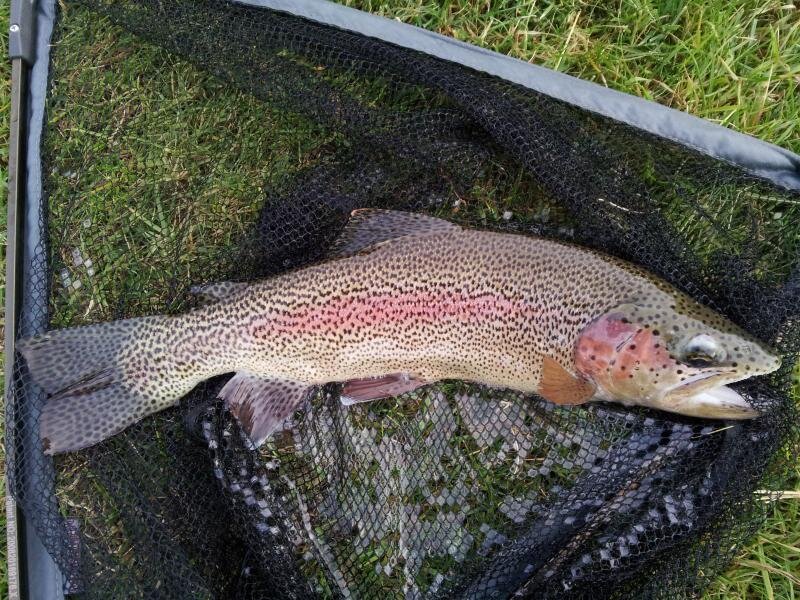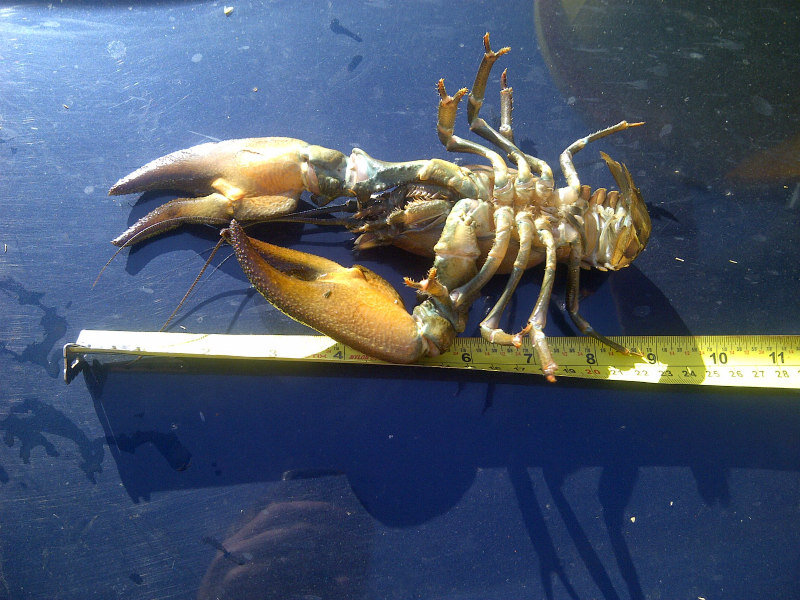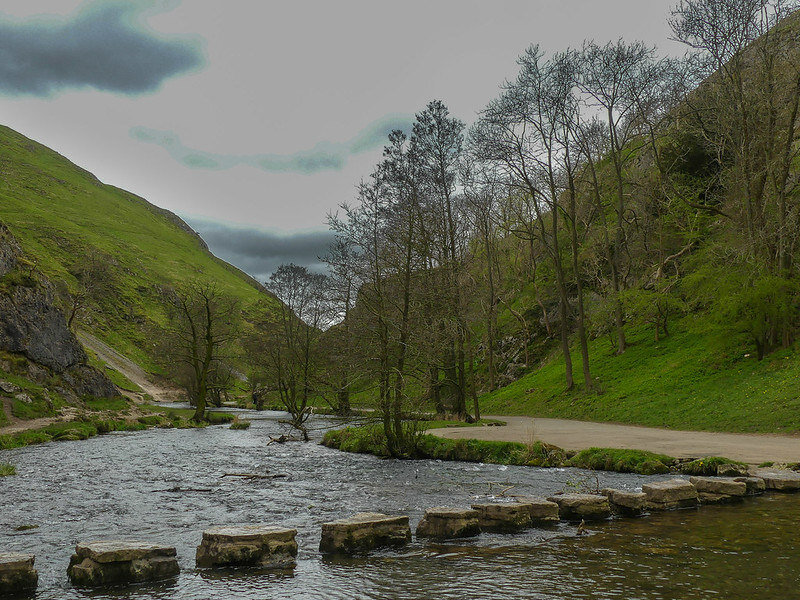Chalk stream fishing in Northern England
/When you mention ‘chalk streams’ to most fly anglers, the Test, the Itchen, the Nadder and the Frome are among the first names that spring to mind. All of these are in the south of England and get a lot of action. However, if you head ‘up north’ you will find two of England’s finest chalk streams that represent the pinnacle of the sport. I’m talking about the Lathkill and the Wye. Last year, I got to fish them and I’m going to share my experience here. But don’t tell too many people because these are two secrets you don’t want to give away too freely.
The Lathkill. Image: Jan Hobot.
Where can the Lathkill and the Wye be found?
The Wye and Lathkill are two chalk streams that flow through the Peak District National Park in Derbyshire. The Peak District National Park is one of 10 National Parks in England and can be found in the country’s heart between the cities of Manchester and Sheffield. The Peak District rises up above the surrounding lowlands and can be divided into two main areas that are defined by their geology called the Dark Peak and the White Peak.
The White Peak is more undulating and consists of limestone outcrops, whereas the Dark Peak which surrounds the white, is more elevated and is composed of darker gritstone. This differing geology gives each area a distinct look and character. The Lathkill and Wye Rivers can be found in the White Peak and both run through limestone and as a result are classed as chalk streams.
The Dukes Beat on the Lathkill. Image: Jan Hobot.
What is a chalk stream?
Before we take a closer look at these rivers, let’s just recap what a chalk stream is. They are streams that flow through ‘chalk’ which is a form of limestone - a highly porous sedimentary rock composed of calcium carbonate.
Chalk streams are typically formed when rain falls on chalk hills and percolates through the porous limestone rock to form aquifers and underground watercourses. This water then usually emerges as a spring from which a stream is formed further down the valley. Because the porous limestone acts as a ‘sponge’ it regulates the amount of water supplied to the stream. This means that unlike freestone rivers that rise and fall quite dramatically with rainfall, chalk streams have pretty stable flows.
Chalk streams are renowned for being crystal clear and being very productive. This is because the slightly acidic rainwater filters through layers of limestone and dissolves the rock to become slightly alkaline and mineral-rich. This, in turn, creates the perfect conditions for in-stream and streamside vegetation to thrive and provide habitat and food for a plethora of insects and invertebrates that trout love.
Lower Lathkill - a pristine example of a chalk stream. Image: Jan Hobot.
What is it that makes the Lathkill & Wye so special?
For a start, they’re off the beaten track. When you Google ‘chalk stream fly fishing England’ pages come up about the chalk streams of southern England. Yet the Lathkill and Wye are nowhere to be found despite them being featured as fishing nivarnas and written up centuries ago in the famous ‘Compleat Angler’ by Izaack Walton.
The author’s friend Charles Cotton wrote of the Lathkill specifically: “it is the purest and most transparent stream that I ever yet saw. And breeds, it is said, the reddest and the best trouts in England.”
It is indeed one of the clearest waters I’ve ever fished and this is because it is the only stream in Britain to rise and flow in its entirety through limestone. This makes its water quite alkaline, unbelievably crystalline and incredibly pure. You can see the fish quite clearly many metres from where they’re sitting … and they can see you too!
The Wye is special because it is nationally renowned for its fly life and has been a dry fly only water since 1865! The Wye has the only population of spring spawning wild rainbow trout in the UK. They came from California in the 1890's. The eyed ova were hatched into a lake above Bakewell and escaped into the river after a flood. No other river in the UK has them.
One of the best parts of fishing these rivers, apart from catching 10 beautiful wild fish, was spending time with Jan Hobot, one of the river keepers on the Haddon Estate, to learn more about what sets these chalk streams apart.
Wild Wye rainbow. Image: Jan Hobot.
Catchment management
Haddon Estate - the family home of Lord Edward Manners - owns most of the Lathkill River and controls a 7.5 mile stretch of the Wye River. This is very important because it means the Estate has a massive influence over the management of catchment and the resulting health of the river. And fortunately, the Manners family are passionate land custodians. For example, the Estate insists the entire valley floor of Lathkill is preserved as a sanctuary for its waters and does not allow any of its tenant farmers to add artificial fertilizer or herbicides to their meadows.
On the Wye, the Estate either directly manages the farmland alongside the river or lets it to progressive farmers. What this means is that the Estate can fearlessly pursue its philosophy of stewardship, without interference from others, to ensure the catchment is managed in a way that creates a rich and ecologically diverse environment that works in the best interests of wildlife and anglers.
This level of control over the catchment is quite rare and sets it apart from many southern chalk streams that are owned and managed by many different people, each with their own philosophy and interests that do not always serve the river well.
When you fish the Lathkill and Wye you instantly know you are fishing two very special rivers because they managed with the sole purpose of creating a wonderland of plants, birds, animals and wild fish.
Haddon Riverkeepers Jan Hobot and Warren Slaney
Dedicated river keepers
Haddon Estate employs two full-time river keepers - Jan Hobot and Warren Slaney. I got to hang out with Jan and when I asked him what his vision was for the river this is what he said:
“All I want is rivers to be natural. Full of invertebrate life, self-sustaining wild trout, and teaming with all the species that are meant to live in and around the river corridor.
I don’t want manicured paths, no stocking, no spraying or over-enrichment from farmers. We are not here to make profits from the rivers. The anglers that visit us help support how the rivers should truly be looked after without a negative impact.”
Sounds like utopia, right? Well, it really is and these guys are wholeheartedly supported by the Estate to turn this vision into a reality. But it’s not easy work. So how do they do it?
Providing clean gravel for spawning. Image: Jan Hobot.
Habitat, habitat and more habitat.
For a wild fishery to flourish, habitat needs to be provided for fish of all ages classes. One of the first things the keepers do is fence off the rivers to cattle and livestock to a maximum of 8 metres.
Spawning gravels should be clean (i.e. silt free), ideally in pinch points and uplifts on rivers. Some rivers do this through natural processes of erosion and deposition. Where this doesn’t occur the river keepers introduce gravel into the right areas.
Just downstream of the gravels, the alevins need protection from being eaten by bigger fish. The riverkeepers do this by planting species like flag iris or putting bundles of willow branches, secured to the bank, into the water to provide cover.
Willow bundles - great cover for juvenile fish. Image: Jan Hobot.
Once the fish grow, they need to move into faster flowing shallow water to avoid getting eaten by larger fish and birds. Where this kind of habitat isn’t in natural abundance, the riverkeepers will sometimes raise areas of the river with large cobbles, allowing independent territories to be made. This is good for 1 – 2 year old fish, meaning they can feed in relative safety. Once the fish grow, they can move into deeper water where they can fight against older fish for the ‘Best lie’.
Jan says a river can never have enough cover. He provides this by manipulating trees so their branches hang into the water, using large instream rocks and installing upstream croys to deflect the flow and provide new fish sitting areas.
Zero tolerance toward non-native invasive species.
All that hard habitat work would go to waste if it wasn’t matched with a zero-tolerance policy toward invasive species.
American mink - the escapees from local fur farms - have a devastating effect on native species such as fish and water voles. The keepers trap and dispatch them year-round.
American signal crayfish is another unwelcome visitor. This pest carries the crayfish plague which kills native white-clawed crayfish. Signals also eat all invertebrates which have a knock on effect to the food chain in the river and they cause damage to the river banks through burrowing. The keepers trap and remove American signal crayfish - apparently, they taste like lobster so many end up in the pot.
Himalayan Balsam is a plant that strangles and outcompetes everything and then dies back in the winter leaving the banks prone to erosion. This weed is strimmed and pulled to try to eliminate the seed base.
And vermin such as cormorants and goosanders are kept under control by shooting them under licence.
The American signal crayfish - an unwelcome intruder in Britain. Image: Jan Hobot.
No stocking.
The estate stopped stocking in June 2003. Why? Because it was having a negative impact on the wild fish population.
In Jan’s view, stocking is used to cover up ‘failing’ rivers where not enough habitat management is done for all trout age classes. A natural river has all different sizes of fish, not just 3 lb or larger fish that have been hatchery grown and stocked. And I agree and would prefer to fish such waters.
However, on other chalk streams, including several famous ones down south, stocking does occur because fishery owners are under pressure to provide easy fishing in nice settings and can charge a lot of money for it.
The philosophy on the Lathkill and Wye Rivers is completely different and by fishing it you will be supporting a river that is run for the fish and its inhabitants, not the anglers and not for profit. And yet paradoxically, you will enjoy some of the most spectacular dry fly, sight fishing there is to have. For me, this is the stuff of dreams.
Beautiful Lathkill brownie
So what's fishing like?
Hard and very rewarding! I fished two private beats - the Dukes Beat on the Lathkill and The Hall beat on the Wye. Day tickets and bookings for private beats can be made by contacting The Peacock hotel - a fantastic boutique hotel and restaurant well worth a visit.
The Dukes Beat only holds brown trout because the rainbows and grayling can’t climb the weir at Alport.
The Hall Beat holds grayling and rainbows - I only caught rainbows. I’m yet to catch a grayling.
Both beats are more expensive than other options but you’re paying for the fact they are very lightly fished and set in stunning private grounds.
I fished them in late July on a sunny and scorching day (well, for England) - just shy of 30 degrees celsius. The water level was fair on the Wye but a little low on the Lathkill.
The water clarity was great on both rivers but the Lathkill was next level clear. It was bank fishing only, no wading, so you couldn’t always get yourself into a good spot to cast into the hot zone - but that half the fun!
I started the day on the Hall Beat on the Wye. It was just magical, my dad and I drove in through a private gate past Haddon Hall - a medieval manor house - and stopped underneath a majestic oak where we geared up.
The air was muggy, the bees were buzzing, there were insects everywhere and I was more than a bit eager to cast a line.
We walked downstream, stopping at each hotspot saying - “that looks awesome, but we’ll go a bit further down and come back to that one”. I finally called it and my dad happily dropped in line - it was a ripper looking section.
I tied on a small, tanned elk hair caddis and made my first cast. I worked at the nearest bank first and then the tail of a pool, nothing played. And then I chucked one out into the middle of the head of the pool and bang - I was on. My dad was beside himself, tripping over the net, telling me to keep it from bombing into some snags. A beautiful 2lb brown trout leapt and dived all over the shop for about 5 minutes before we landed him. Dad nearly took a swim in the drink because the fish was hard to net from the bank. All this excitement within the first 15 minutes of the trip!
Landing my first Lathkill brown is something I’ll never forget because these fish were bloody hard to catch. There were sections where I could see them, clear as day, and I reckon they could see me but they didn’t budge. Despite numerous fly changes, they just sat there and did nothing.
So, I moved on and tried my luck in another section. It was a more open section, with slow glides where I could make longer casts. In this particular section, I decided to put on a small grey para adams. I changed my tippet and made it a tad longer. I worked the near sections first - no love. I then decided to make a really long cast to a particularly sweet looking section and it was taken as soon as it landed! Striking at such a distance was a risk but I managed to set the hook alright. I relaxed after I caught this fella and managed to get a few more on this river in the late afternoon and evening.
The Wye ‘Hall Beat’ in all its glory
What kind of candy works on the Lathkill and Wye?
In terms of what flies to pack in your fly box it all depends on when you go.
The season opens in April and during the early weeks up until May, large dark olive and Grannom hatches are short but the fishing can be great when it’s on. Greenwell’s Glory, Kite Imperial and Grannom pupa emergers would be good to have in the armoury at this time.
Mid-Season (Mid May to End June) marks the Hawthorn and Mayfly hatches, which are usually exceptionally good! So packing some Hawthorn fly patterns and some para adams, pale morning duns and other mayfly imitations would be good.
The Summer season - which is when I was fishing - (July – Sept) sees good hatches of blue-winged olives, caddis, and all other species through the day. And on a warm windless evening, an evening rise of sherry spinners.
During the morning, I did particularly well on a couple of small elk hair caddis and F flies.
In the afternoon, I tied on blue-winged olive patterns, and the evening was all about small orange spinner patterns. You wouldn’t go a miss packing a good detached mayfly pattern (like an Oliver Edwards) and a double badger (gnat pattern) too.
Haddon Hall. Image: Billy Wilson.
Get inspired about going fishing in Derbyshire now
Hopefully, by now I’ve convinced you about why you need to fish the Wye and Lathkill. However, there are plenty of other reasons why you should visit the region - something that’s really important if you’re travelling with family or non-fishing mad friends.
Right on the doorstep of the Wye and Lathkill is Haddon Hall. Described as ‘the most perfect house to survive from the middle ages’ the hall is a history lover's haven.
Around the corner, is Chatsworth House which is a lavish stately home with an incredible art collection, jaw-dropping gardens, adventure playground, kids farmyard and awesome farm shop. You could spend a couple of days here and still not see it all - it is a must-visit for all the family.
Finally, I would highly recommend a drive down to Dovedale to see (and potentially fish) the river that Izaac Walton and Charles Cotton regularly fished and inspired Walton to write the Compleat Angler. There is a stunning, easy-going walk alongside the Rover Dove that takes you through the most beautiful limestone country. Day tickets to fish the river can be purchased from the Izaac Walton Hotel - which is a great place for a few beers and a bite to eat.
Dovedale. Image: Mike Prince.













